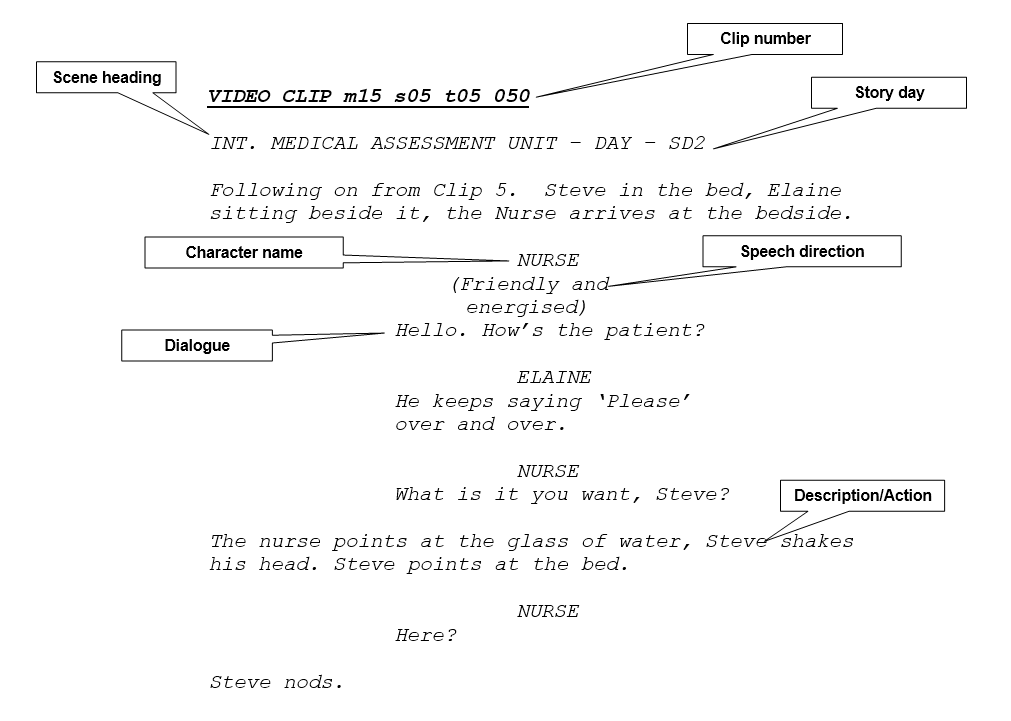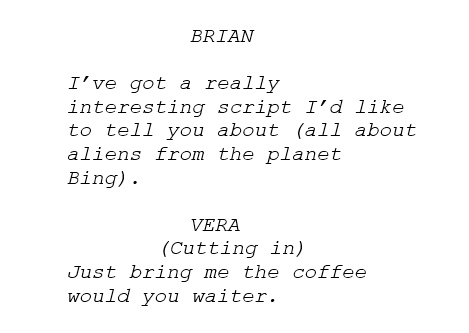For the video producer a script is set of instructions for how to make the film. That’s why even within an e-learning script we need the standard elements of a video script.
Receiving scripts in a standard format greatly speeds up our understanding of the content and makes it easy to break down to create costings and production plans. In short, if you speak our language we can do a more efficient job for you.
Here’s a video script excerpt with some notes to explain:
Clip number
If there are no scene numbers we will add some, although they will not fit any authorware specs.
Scene heading
This comprises:
– INT OR EXT (interior or exterior)
– Location
– Time of day (this is usually as simple as “Day”)
Even if a scene is a continuation of a scenario already established we need the scene heading information.
Story Day
At the end of the scene heading is a little number with the prefix “SD” standing for “Story Day”. This number shows the passing of time across a series of scenes – most obviously characters will wear different clothes.
Leave it off if showing the passing of time is not relevant to the content.
Description/Action
Description in a script has two functions. The first is to describe elements of the scene which are relevant to the story: “Steve gets into his car and turns the ignition”.
The second is to set the scene – in the hospital scene above, one might have written: “In the gloomy ward chatter comes from adjacent beds”. It gives an indication of the mood and style.
All the video scenes should begin with at least a description to show who is in the room etc. This helps the producer because the scenes will be cut and pasted into filming order, different from the script order.
Only action relevant to the story (or learning objectives) need to be included. In theatre scripts action is sometimes put in brackets after the name of the character. In video scripts this space is reserved for speech directions.
Very occasionally one needs to put in a camera direction. The word CAMERA should be in capitals to draw attention to this. Shot sizes, such as CLOSE-UP should also be in caps.
Character name
These should be in capitals, making them quickly recognisable.
Character names must be consistent throughout the script.
Speech directions
Usually in brackets below the character name.
Dialogue
In so far as a script is a set of instructions to create a video, dialogue is no exception. For example, it can be useful to write numbers in full to make sure the speech matches the intention of the writer. (e.g. “one thousand and one” rather an “1001”).
A useful devise for actors if you are writing a scene in which one character interrupts the speech of another is to put a few words that they would have said if they weren’t interrupted in brackets at the end of their speech, and to add the speech direction “Cutting in” before the following speech. Like this:
This gives actors a through-line and can improve the performance.
If a character is heard but not seen write “O.S.” for “Off Screen” after the character name on the same line.
The script sample shown is for dramatized sequences, but this format will also work quite well for documentary content. The description layout describes the shots, while the voice-over can be written as dialogue with the character name “NARRATOR”. Another way to write this sort of content is with voice in a column on the left and the picture opposite.
If this layout doesn’t fit within your e-learning script format it will still help your video producers if you keep the format elements but alter the layout to fit your document.









